Cruising The French West Indies
Island Hopping in this season of Covid
Story and Photos by David H. Lyman
This article was published in the
December 2021 edition of Caribbean Compass
Welcome to the Islands!
Your romp through the Leeward and Windward Island will be different this year. Gone are the devil-may-care days we use to have . . . just drop the hook, back down to set it, jump into the dinghy and go ashore for a beer.
No, this season, there will be Covid Regulations to abide by, forms to fill out, tests to take, vaccinations to be taken. But the islands are the same, tho moist people ashore maybe wearing masks.
Let’s Do the French Islands!
If you are coming south from the BVI head for Deshaies at the northern tip of Guadeloupe. It’s 200 miles, a day and a half sail, to this very French harbor village. If coming south from Saint Barts, another French island, it’s only 115 miles, a long day’s beat to this small port tucked in between two cliffs.
If you’ve just arrived into Rodney Bay on the ARC, you can head south or north. From St. Lucia south, it’s only 75 miles to Bequia, where you can clear in and begin your exploration of the Grenadines. But, If you head north, from Rodney Bay, it’s only 2o miles to the open roadstead of Saint Anne, a small French village along the beach at the souther tip of Martinique. You can be there for lunch.
Let me tell you about Saint Anne. The roadstead is easy to enter and the holding ground is good, but there are bare spots so make sure the anchor is well dug in. It’s so nice here there are usually more than 200 boats at anchor. I counted them. There’s a substantial dinghy dock ashore, which can be jam-packed. This sleepy, two street town along the beach has a few cafes, bars, restaurants, a boulangerie, two small grocery stores, an open air market, fish market, and an ATM. Wifi costs you a beer, or lunch.
There’s a Cub Med nearby, with a long beach crowded with French vacationers. To the west of the village are more secluded beaches and trails. The are reefs for snorkeling within dinghy distance. There is a pathway up the hill behind the village. The zig-zag path follows the Stations of the Cross, with a stone monument at each turn depicting Christ’s ordeal. At the top you are met by a concrete cell tower building, but turn and look back out over the roadstead filled with white yachts glistening in the sun. It’s inspiring.
There are no marine services, no water, fuel, or boat parts in Saint Anne. All that is found a few miles further into the Cul-de-sac du Marin, one of the largest marine complexes in the Caribbean. Here this is a large fuel dock, marinas, charter fleets, ships stores, chandleries, supermarkets, repair yards, and every service you could want. It’s better if you speak French.
Heading north, along the coast of Martinique are two more small anchorages, then the large port-city of Fort de France, a bustling hub of commercial activity. Lots of anchorages, but I’d scoot north up the coast to St. Pierre. It’s only 30 miles from Saint Anne, a day sail, well, a motor-sail as there’s little wind in the lee of the big island.
The anchorage along this beach town is a narrow shelf that extends 500 feet from shore, then drops off, way off. If there’s a northerly swell running this will be an uncomfortable anchorage. If not, take the dinghy into the substantial town wharf, the customs and immigration office is a computer in the building with the clock. It’s a DIY process. There’s a farmers market on the plaza, and the street is lined with stores, restaurants and residents.
Saint Pierre sits at the foot of Mount Pele, a (hopefully) dormant volcano. It last blew its top in 1902, wiping out 30,000 residents. Its summit is usually capped with a plumb of clouds, but the hike to the top is rewarding. From there you see (once below the clouds) the whole island before you to the south. Patchwork agricultural fields give way to rain forest jungles that climb into the raising mountains. Rent a car in Saint Pierre and spend a day or two exploring this island. The road are better than on many Caribbean islands, as France still owns her Caribbean colonies and spends lavishly on their infrastructure. When the Brits departed their colonies, the islands were left to fend for themselves
Up in the mountains there are water falls, cascading rivers and brooks, pools for swimming and along the coast, villages with cafes. You could be on the French Reviera.
The next island north is Dominica, a former Brit castoff. This, the largest and tallest of all the Caribbean islands, and the most wild. It is certainly worth a visit, if the Covid regulations are agreeable. The major anchorage is Prince Rupert Bay, at the north end of the island. There are moorings to rent, a safety patrol, and lots of room to anchor. Clear in at the commercial dock south of Indian River. Ashore the town of Portsmouth is a bit worn out, with few services, but Dominica’s charms lay inland. Rent a car and head into the mountainous rain forest to find water falls, pools for summing and native Carib villages. A guided tour up the Indian River, rowed by a local guide, is a quiet journey into Jurassic Park.
From Prince Rupert Bay it’s 20 miles to Iles des Saintes, or The Saints, a archipelago of five islands, 6 miles south of Guadeloupe. There are lots of options for anchoring, or pick up a rental mooring closer into the village on Terre-de-Haut, the largest of the islands.
There’s a designated dinghy dock to the left of the large ferry dock. The town has one major street, lined with boutiques, restaurants, cafes, bike and moped rental shops. There are no cars on the island. By mid-morning ferries from the mainland will disgorged day-trippers heading to the beaches on the east side of the island. They’ll all be gone by 4, returning this French village to it’s residents and a few of us cruisers relaxing in the afternoon sun among the cafes on the beach.
Another 20 miles up the West side of Guadeloupe are two place to drop the hook. The first is Pigeon Cove, adjacent to the Jacque Cousteau under water park. Ashore, along the black sand beach are numerous dive shops to take you out to the park to snorkel or strap on a tank and dive deeper. It’s worth an overnight, but tuck in close, as the shelf drops off quickly.
An hour north of Pigeon Cover is a picturesque port of Deshaies, protected between two cliffs. Now, this is my idea of a West Indian gem. Ashore, this one street town as all one needs, three small grocery stores, a lone farmer sets up his stand mid-morning, there is a ATM, three dive shops, and a patisserie directly across from the dinghy dock. There is a rental car agency, wine store and you’ll find the customs and immigrations office in La Pelican boutique, a few steps to the right of the dinghy dock. There are hiking trails into the hills along a cascading brook with pools for swimming. A mile south of the village is an extensive botanical garden that’s worth a day’s exploration. To the north of the harbor, just around the cliff, is a mile long sand beach. You can walk or take the dinghy and you’ll find few people there.
I could spent weeks in Deshaies, but paradise comes with her blemishes. The holding ground is hard, making anchoring challenging. The winds can come blasting through the mountain valleys keeping the skipper up all night with worry. If there’s a winter storm lashing the East Coast of the US, swells reach all the way into the Caribbean, and create uncomfortable and dangerous condition in this small anchorage. I had to up anchor and escape a few years ago.
From Deshaies you have choices. It’s 45 miles to English Harbor on Antigua, 120 miles to Saint Barts, and over night sail, but the wind will be on the quarter all the way. Tuck into Anse Colmbier, a wide bay at the northern tip of St. Barts. There’s a seldom used beach, hiking trails, a few goats, and a 2 mile dinghy ride into the village of Gustavia. You could mistake this small harbor village for Saint Tropez. Here’s where the Eurotrash congregate in the winter, when not in Ibiza. There are chic boutiques, expensive restaurants, megayachts packed stern-to along the promenade. You’ll see movie stars, rock stars, maybe Jimmy Buffett.
Last stop on your tour of the French West Indies is the French side of Saint Martin, about 20 miles downwind. Marigot Bay, on the northwest side of the island, is a large anchorage with a town ashore. Before leaving St. Barts, check on entry requirements. While you can drive a car or dinghy between the French and Dutch sides of this island, you can’t sail around without clearing in and out of each side.
By now, you’ll have spent a good portion of your allotted time in the Caribbean, it not all of it. Saint Marten is a good place to provision (all that great French cheese and pate) and prepare the boat for the voyage north to Bermuda, then on to Europe or the East Coast of the US.
I imagine you’ll be back. I can’t stay away and I’ve been here a lifetime.

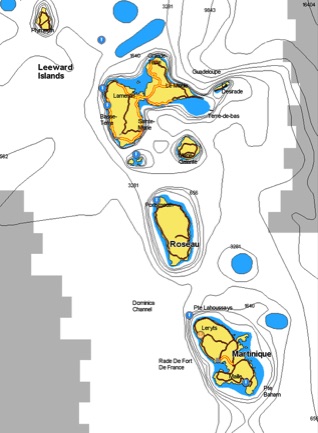
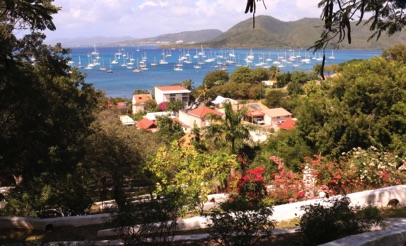
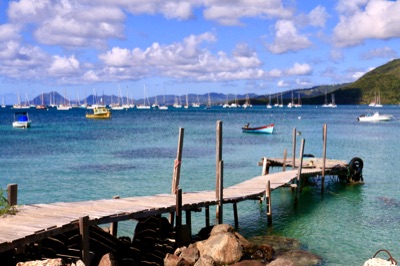
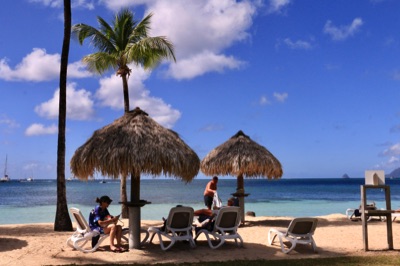
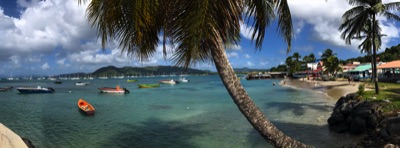
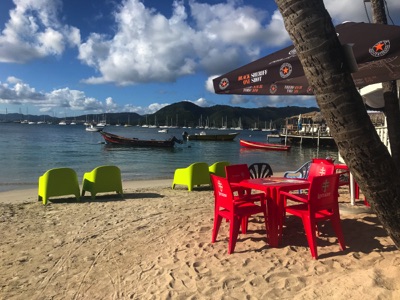
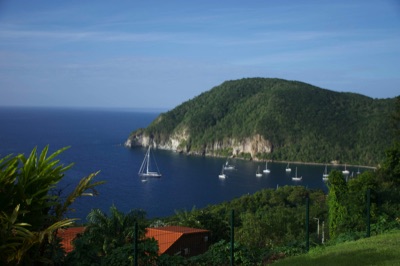
Arriving in the French Islands
Clearning into any one of the French islands, in normal times, is breeze. While on other islands you are made to visit multiply offices, often in different buildings, stand in line, fill in forms, have your papers scrutinized, stamped and with authority. In the French West Indies, you simply come ashore to locate the customs and immigrations office, usually a computer terminal stuck in the corner of a bar, boutique, the town hall. You sit there for half an hour trying to figure out what the form wants, its in French, someone comes over to check your input, sticks their hand out for the 4 euros, pressed the “send” button, hands you a printed copy of the your document. All so civilized, and it was the French who invented the term “bureaucracy.”
The other islands, especially the former English colonies, are much more complex, and costly. So if I was to choose one particular group of islands, like Larry, it would be the French Islands. And, I don’t speak French. It also the the food, much of it flown in from Paris or locally grown, good, cheap wine, and the laid-back attitude of the locals . . . I could spend the entire winter floating around the French West Indies.